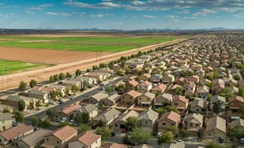Author: Rick Codina
In March 2023, SMUD announced it is in active discussion with Calpine Energy to participate in a carbon sequestration project at its Yuba City Sutter Energy Center. SMUD currently contracts for power from this gas-powered generation unit. The proposal would transform the generator to a major carbon-free source of power for SMUD. 1
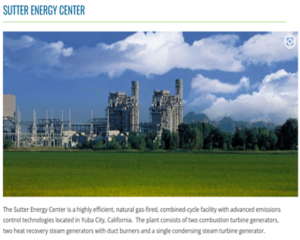 By adding sequestration equipment, Calpine can continue operating its gas-fired power plant, while securing up to 98% of its carbon dioxide emissions in an EPA-approved Class VI site in a nearby underground geologically stable rock, thousands of feet below the surface.
By adding sequestration equipment, Calpine can continue operating its gas-fired power plant, while securing up to 98% of its carbon dioxide emissions in an EPA-approved Class VI site in a nearby underground geologically stable rock, thousands of feet below the surface.
The company will be seeking a Department of Energy (DOE) grant to cover 25% – 50% of the carbon sequestration plant addition, while self-funding the remaining capital investment. SMUD’s participation would be limited to a 10-15 year contract for the power output, probably starting around 2027.
This venture would be a gamechanger for SMUD’s Climate Zero efforts, providing it with a much-needed source of 24/7 baseline power to cover periods of power availability from intermittent sources such as solar and wind.
SMUD is soliciting support for the DOE grant and power contract from the community. SMUD staff will be providing more information on the Calpine carbon sequestration proposal currently at the March 15, 2023, SMUD Board meeting at 6:00 pm.
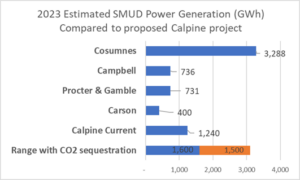 How much power? The new CO2-sequestered contracted power ranges between 1,600 to 3,100 GWh, replacing SMUD’s current Calpine contract plus one or more cogeneration units (see chart).
How much power? The new CO2-sequestered contracted power ranges between 1,600 to 3,100 GWh, replacing SMUD’s current Calpine contract plus one or more cogeneration units (see chart).
How much GHG sequestered? The range of CO2 sequestered is 461,000 to 892,000 metric tons. This is around 20% – 40% of SMUD’s current GHG emissions.
SMUD Benefits
- It creates a base load, carbon-free power source with 24-hour reliability during extended weather events and other times when renewable power such as solar and wind are unavailable. The January 2023 storms, for example, lasted weeks rendering these intermittent resources, and short-duration batteries of little help.
- The project will more broadly support reliability across the Western states power grid.
- By repurposing the existing generation unit, the project will add carbon-free power without the loss of agricultural or other valuable land otherwise required for a new renewable utility-scale power plant.
- Staff believes the contract power will be competitive with solar + storage pricing.
- The relatively short-term duration of the contract will allow SMUD to pursue other longer-term replacement power sources with technologies still under development.2
Concerns Over the Project
- Due diligence. In general, SMUD needs to provide more data to assess the degree and likelihood of the risk and liability from malfunctions or leaks. Also needed is more detail on the longevity of the project and the volume of annual storage compared to underground capacity.
- Long-term leakage. Can SMUD provide studies on the geologic stability of the storage site? While deep rock storage is dissimilar to gas storage caverns, the history of leakage of methane in these chambers is concerning, such as Wild Goose LLC near the Sutter Buttes, and the disastrous Aliso Canyon in southern California?
- Pipeline safety. Transporting CO2to injection sites involves pipelines which have been known to leak and rupture. The Center for Biological Diversity notes that “compressed CO2 is highly hazardous upon release, forming a cold, dense cloud that sinks to the ground and can sicken and asphyxiate humans and animals. In February 2020, 300 people were evacuated and 45 people hospitalized when a CO2 pipeline ruptured in rural Yazoo County, Mississippi.” 3
- Added chemical risk. What additional toxic chemicals such as lye and ammonia will be required for the CO2 capture and what measures will be in place to safeguard their use?
- What is success for carbon capture? The La Porte Texas facility closed in 2020 after capturing only a fraction of the carbon at that site. And Chevron’s Gorgon plant in Australia, self-described as the “world’s biggest CCS project,” reportedly failed to meet its five-year CO2-capture target of 80%, instead capturing only 30% of its CO2 What factors will ensure success at the Calpine plant?
- Risk of tethering SMUD to Calpine. The long-term contract will result in SMUD dependence on the Calpine power plant until the 2040’s for a large part of its Carbon Zero goal. What contingencies does SMUD have for failure of the plant or the carbon capture equipment?
- Financial risk. Aside from equipment failure, is SMUD protected from future rising natural gas prices or other operational cost increases?
- Fossil fuel dependence. While the project promises near carbon-zero emissions, the Calpine plant will continue to burn natural gas for at least the 10-15 years of SMUD’s contract. What are SMUD’s plans to transition away from this power source to a true, non-fossil fuel based source of generation?
Appendix: Geological Carbon Capture and Sequestration
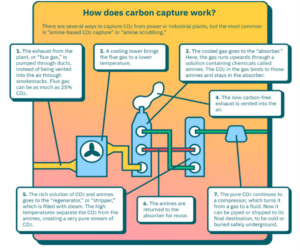 The technology for capturing carbon dioxide from industrial or natural gas power plants is fairly well established with working examples in Europe and the United States. The most common method separates the CO2 after combustion, as shown in this MIT Climate Portal illustration at right.
The technology for capturing carbon dioxide from industrial or natural gas power plants is fairly well established with working examples in Europe and the United States. The most common method separates the CO2 after combustion, as shown in this MIT Climate Portal illustration at right.
Another leading contender is the Allam Fetvedt process which captures the carbon up front. The La Porte Texas plant shown below is the most successful application of this method to date.
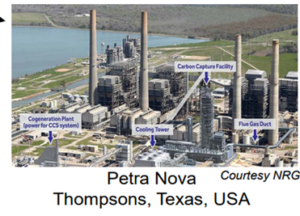 The end result is liquid, pressurized CO2 which can then be piped for underground storage in deep rock formations. These geologically stable sites are plentiful in California according to a September 2021 presentation by the Stanford Center for Carbon Storage to the SMUD Board (shown below).
The end result is liquid, pressurized CO2 which can then be piped for underground storage in deep rock formations. These geologically stable sites are plentiful in California according to a September 2021 presentation by the Stanford Center for Carbon Storage to the SMUD Board (shown below).
To utilize these sites, applicants must apply to the Environmental Protection Agency (EPA) for a Class VI disposal permit.4 Currently, the EPA is processing dozens of Class VI applications, although only two ADM projects5 in Illinois have as yet been approved and active.
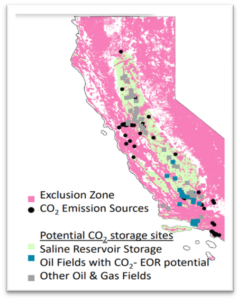 In California, Carbon Terravault is the primary Class VI applicant with its Kern County application6 expecting approval in 2023. It also has several proposed sites in the Calpine project area under consideration for approval in the 2025-27 timeframe. Carbon Terravault is a newly formed subsidiary of California Resource Corporation, an oil and gas drilling company.
In California, Carbon Terravault is the primary Class VI applicant with its Kern County application6 expecting approval in 2023. It also has several proposed sites in the Calpine project area under consideration for approval in the 2025-27 timeframe. Carbon Terravault is a newly formed subsidiary of California Resource Corporation, an oil and gas drilling company.Class VI wells must adhere to detailed criteria set by the EPA covering the following categories:
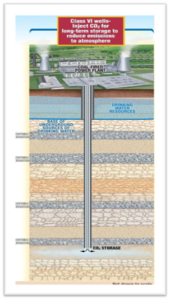 Extensive site characterization requirements.
Extensive site characterization requirements.- Injection well construction requirements for materials that are compatible with and can withstand contact with CO2 over the life of a Geologic Sequestration (GS)project.
- Injection well operation requirements.
- Comprehensive monitoring requirements that address all aspects of well integrity, CO2 injection and storage, and ground water quality during the injection operation and the post-injection site care period.
- Financial responsibility requirements assuring the availability of funds for the life of a GS project (including post-injection site care and emergency response).
- Reporting and recordkeeping requirements that provide project-specific information to continually evaluate Class VI operations and confirm USDW protection.
It is important to note that the CO2 is not stored in underground caverns or dry methane chambers. Instead, the compressed, liquid gas is injected into solid, but porous rock. The CO2 becomes trapped in the pore spaces of the rock formations, thousands of feet underneath impermeable cap rock. Over time, the CO2 dissolves into the pore water or may be transformed into solid minerals.
Nor are the wells subject to earthquakes. Under EPA’s Underground Injection Control (UIC) regulations, geologic sequestration sites will be located in seismically stable, non-volcanic areas. The pressure build-up resulting from CO2 injection could cause minor seismic events, though most of these would be too small to be noticed.
 Funding Deadline: On February 23rd, DOE announced up to $270 million for demonstration projects at natural gas electric generation facilities with commercial-scale carbon capture technologies integrated with carbon dioxide transportation and geologic storage infrastructure.7
Funding Deadline: On February 23rd, DOE announced up to $270 million for demonstration projects at natural gas electric generation facilities with commercial-scale carbon capture technologies integrated with carbon dioxide transportation and geologic storage infrastructure.7Notes:
1 Information based on phone conversation with Bryan Swann, SMUD Director of Resource Strategy and James Frasher, SMUD Manager of New Business Development, March 1, 2023.
2 SMUD, for example, is simultaneously working with the Alliance for Renewable, Clean Hydrogen Energy Sources (ARCHES), a state-wide hydrogen consortium seeking up to $8 billion in DOE grant money to establish hydrogen hubs that can be used as a green fuel for both transportation and power plants.
3 https://www.biologicaldiversity.org/campaigns/carbon-capture-and-storage/index.html
4 Class VI – Wells used for Geologic Sequestration of Carbon Dioxide | US EPA
5 For the ADM application, see: https://www.epa.gov/sites/default/files/2021-05/documents/adm_ccs1_permit_without_attachments.pdf
6 The Kern County Planning Department is currently reviewing the EIR for this project: https://psbweb.co.kern.ca.us/planning/pdfs/notices/carbon_terravault1_nop.pdf
7 Funding Notice: Carbon Capture Demonstration Projects Program | Department of Energy



